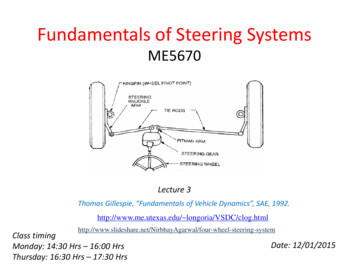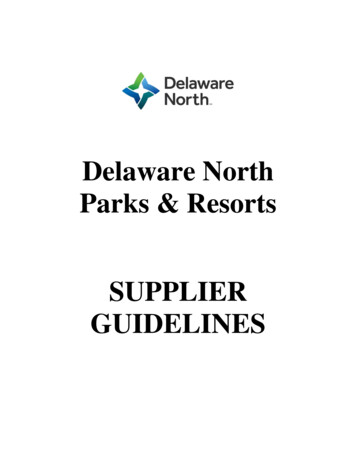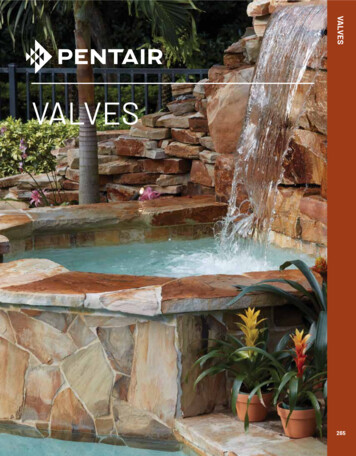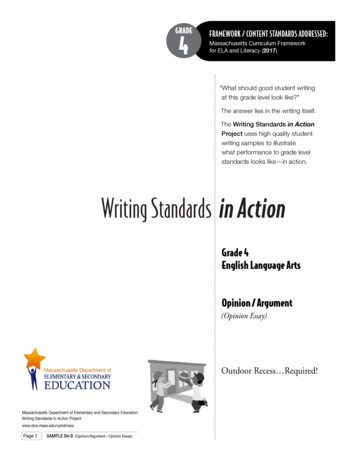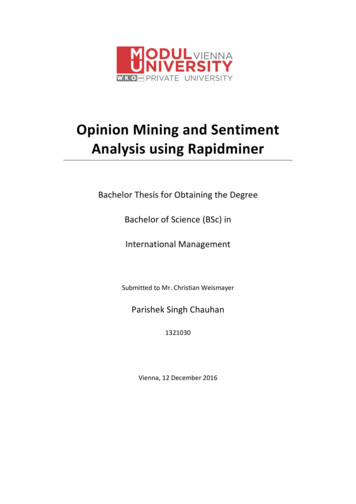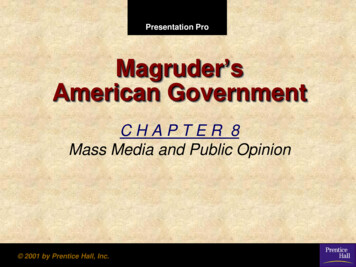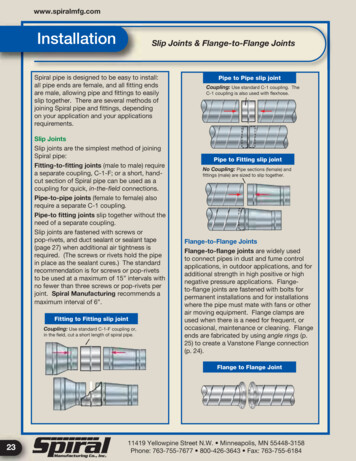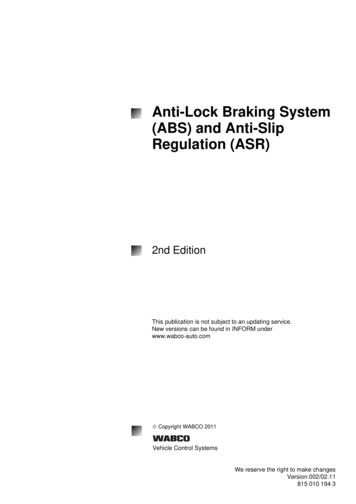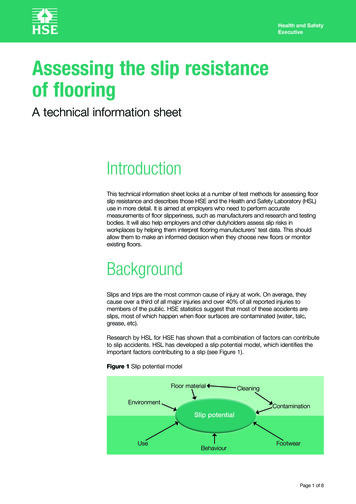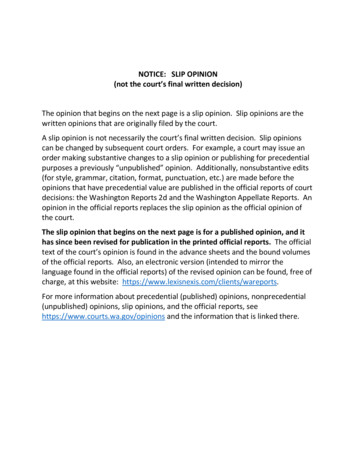
Transcription
NOTICE: SLIP OPINION(not the court’s final written decision)The opinion that begins on the next page is a slip opinion. Slip opinions are thewritten opinions that are originally filed by the court.A slip opinion is not necessarily the court’s final written decision. Slip opinionscan be changed by subsequent court orders. For example, a court may issue anorder making substantive changes to a slip opinion or publishing for precedentialpurposes a previously “unpublished” opinion. Additionally, nonsubstantive edits(for style, grammar, citation, format, punctuation, etc.) are made before theopinions that have precedential value are published in the official reports of courtdecisions: the Washington Reports 2d and the Washington Appellate Reports. Anopinion in the official reports replaces the slip opinion as the official opinion ofthe court.The slip opinion that begins on the next page is for a published opinion, and ithas since been revised for publication in the printed official reports. The officialtext of the court’s opinion is found in the advance sheets and the bound volumesof the official reports. Also, an electronic version (intended to mirror thelanguage found in the official reports) of the revised opinion can be found, free ofcharge, at this website: https://www.lexisnexis.com/clients/wareports.For more information about precedential (published) opinions, nonprecedential(unpublished) opinions, slip opinions, and the official reports, seehttps://www.courts.wa.gov/opinions and the information that is linked there.
IN THE COURT OF APPEALS OF THE STATE OF WASHINGTONMICHAEL FARROW and LIDIAFARROW,Appellants,No. 69917-2-1DIVISION ONEPUBLISHED IN PART OPINIONALFA LAVAL, INC. (sued individuallyand as successor-in-interest to THEDELAVAL SEPARATOR COMPANYand SHARPLES CORPORATION);t-3c ANCHOR/DARLING VALVECOMPANY; AURORA PUMPCOMPANY; BEAIRD COMPANY;BUFFALO PUMPS, INC. (suedIinterest to BUFFALO FORGEsuccessor-in-interest to BYRONJACKSON PUMP COMPANY);CAMERON INTERNATIONALCORPORATION f/k/a COOPERCAMERON CORPORATION (suedindividually and as successor-in-interestto COOPER-BESSEMERCORPORATION); CARRIERCORPORATION; CLA-VAL CO.;CLEAVER-BROOKS, INC. f/k/a AQUA-CHEM, INC. d/b/a CLEAVER-BROOKSDIVISION (sued individually and assuccessor-in-interest to DAVISENGINEERING COMPANY); COLTECINDUSTRIES, INC. (sued individuallyand as successor-in-interest to .—rnindividually and as successor-in-COMPANY); BW/IP INTERNATIONAL,INC. (sued individually and asc ", czCO
No. 69917-2-1/2FAIRBANKS MORSE ENGINE);CRANE CO. (sued individually and assuccessor-in-interest to COCHRANECORPORATION and CHAPMANVALVE CO.); CRANEENVIRONMENTAL, INC. (suedindividually and as successor-in-interestto COCHRANE CORPORATION);CROSBY VALVE, INC.; EATONHYDRAULICS, INC. (sued individuallyand as successor-in-interest toVICKERS INC.); ELLIOTTTURBOMACHINERY COMPANY a/k/aELLIOTT COMPANY; E.J. BARTELLSSETTLEMENT TRUST; FAIRBANKSMORSE PUMP CORPORATION; FMCCORPORATION (sued individually andas successor-in-interest to PEERLESSPUMP COMPANY); FRYERKNOWLES, INC.; FRYER-KNOWLES,INC., a Washington corporation;GARLOCK SEALINGTECHNOLOGIES, L.L.C. (suedindividually and as successor-ininterest to GARLOCK, INC.); GENERALMOTORS CORPORATION (suedindividually and as successor-in-interestto HARRISON THERMAL SYSTEM andHARRISON RADIATOR); GOULDSPUMPS, INC.; HARDIE-TYNES, L.L.C.(sued individually and as successor-ininterest to HARDIE-TYNESMANUFACTURING COMPANY);HARDIE-TYNES MANUFACTURINGCOMPANY; HOKE INCORPORATED;HOPEMAN BROTHERS, INC.;HOPEMAN BROTHERS MARINEINTERIORS, L.L.C. a/k/a HOPEMANBROTHERS, INC.; IMO INDUSTRIES,INC. (sued individually and assuccessor-in-interest to DELAVALTURBINE, INC. and C.H. WHEELER);ITT INDUSTRIES, INC. (suedindividually and as successor-ininterest to BELL & GOSSETT,KENNEDY VALVE MANUFACTURING
No. 69917-2-1/3CO., KENNEDY VALVE, INC. andKENNEDY VALVE CO); INVENSYSSYSTEMS, INC. (sued individually andas successor-in-interest to EDWARDVALVE & MANUFACTURING); J.T.THORPE & SON, INC.; JOHN CRANE,INC.; LESLIE CONTROLS, INC.; M.SLAYEN AND ASSOCIATES, INC.;MCWANE INC. (sued individually andas successor-in-interest to KENNEDYVALVE MANUFACTURING COMPANY,KENNEDY VALVE INC. and KENNEDYVALVE COMPANY); METALCLADINSULATION CORPORATION;METROPOLITAN LIFE INSURANCECOMPANY; PLANT INSULATIONCOMPANY; RAPID-AMERICANCORPORATION (sued as successor-ininterest to PHILIP CAREYMANUFACTURING CORPORATION);SB DECKING, INC. f/k/a SELBYBATTERSBY & CO.; SEPCOCORPORATION; STERLING FLUIDSYSTEMS, INC. f/k/a PEERLESSPUMPS CO; SYD CARPENTER,MARINE CONTRACTOR, INC.;THOMAS DEE ENGINEERING CO.,INC.; TRIPLE A MACHINE SHOP, INC.;TYCO FLOW CONTROL, INC. (suedindividually and as successor-in-interestto THE LUNKENHEIMER COMPANY,and HANCOCK VALVES); WARRENPUMPS, L.L.C. (sued individually andsuccessor-in-interest to QUIMBYPUMP COMPANY); WEIR VALVES &CONTROLS USA, INC. f/k/aATWOOD & MORRILL; THE WILLIAMPOWELL COMPANY; YARWAYCORPORATION; and DOES 1-450INCLUSIVE,Defendants,FLOWSERVE US INC. (suedindividually and as successor-ininterest to DURCO INTERNATIONAL,
No. 69917-2-1/4BYRON JACKSON PUMP COMPANY, )ALDRICH and EDWARD VALVE &)MANUFACTURING),))Respondents.))FILED: March 3,2014Dwyer, J. — Michael Farrow died in 2008 as a result of contractingmesothelioma. Prior to his death, he and his wife, Lidia Farrow, filed a lawsuitagainst a number of defendants, including Flowserve US Inc., who they suedindividually and as successor-in-interest to Edward Valves, Inc. (EVI). TheFarrows alleged that Michael had contracted mesothelioma as a result of beingexposed to asbestos-containing products while working at the Puget SoundNaval Shipyard (PSNS) over the span of two decades. Melvin Wortman, asuperintendent at the PSNS during part of Farrow's tenure, was deposed in adifferent lawsuit, and subsequently died before Farrow's case could be heard.Initially, the trial court allowed Farrow to offer Wortman's testimony, over EVI'shearsay objection, pursuant to the "predecessor in interest" exception of ER804(b)(1).1 However, after excluding Wortman's testimony as to several otherdefendants, the trial court reversed course and excluded his testimony in thiscase, leading to its grant of Flowserve's motion for summary judgment. The trialcourt erred in making the latter rulings. Accordingly, we reverse and remand forfurther proceedings.1(b) Hearsay Exceptions. The following are not excluded by the hearsayrule if the declarant is unavailable as a witness:(1) Former Testimony. Testimony given as a witness at another hearingof the same or a different proceeding, or in a deposition taken in compliance withlaw in the course of the same or another proceeding, if the party against whomthe testimony is now offered, or, in a civil action or proceeding, a predecessor ininterest, had an opportunity and similar motive to develop the testimony by direct,cross, or redirect examination.ER 804.
No. 69917-2-1/5Farrow worked at the PSNS as a pipefitter from 1953 to 1962 and in thedesign shop from 1963 to 1974. As part of his work in both positions, he spent asignificant amount of time aboard ships installing and repairing valves, removingand replacing packing material around the valves' stems, and removing andreplacing flange gaskets. One brand of valve that Farrow worked on and around"many times" was the Edward valve. Farrow removed insulation pads fromEdward valves, removed flange gaskets from and fabricated flange gaskets onEdward valves, and removed packing from Edward valves and replaced the oldpacking with new packing. When Farrow or others nearby removed insulationfrom Edward valves, the air would be dusty and Farrow would breathe that dust.When Farrow or others nearby would remove gaskets from Edward valves, theair would be dusty and Farrow would breathe that dust. When Farrow or othersnearby would fabricate gaskets on Edward valves, the air would be dusty andFarrow would breathe that dust. When Farrow or others nearby would removeold packing from Edward valves, it would very often be dusty and Farrow wouldbreathe that dust. When Farrow or others nearby would replace old packing withnew packing, it would be dusty and Farrow would breathe that dust.Melvin Wortman was a superintendent of machinists at the PSNS fromapproximately 1968 until 1976. Although Wortman is now deceased, he issignificant in this case because of deposition testimony he gave in a previousKing County Superior Court case: Nelson v. Buffalo Pumps, Inc., No. 08-217324-1 SEA. Wortman testified that because the Navy and the PSNS were
No. 69917-2-1/6focused on increasing their quality control during the time when he wassuperintendent, "there was a great increase in going to the original vendor forrepair parts." He testified that in later years approximately 50 percent of thereplacement parts obtained for the PSNS were procured from originalmanufacturers.2 Wortman's deposition in the Nelson case was taken over athree-day period, during which time questions were asked by attorneys fordefendants Crane Co., Buffalo Pumps, Ingersol Rand, and Warren Pumps, andby attorneys for the plaintiffs. Buffalo Pumps manufactured pumps, whereasCrane Co., manufactured valves, and both of these defendants' products wereon ships repaired at the PSNS. See Braaten v. Saberhaqen Holdings, 137 Wn.App. 32, 37, 151 P.3d 1010 (2007), rev'd 165 Wn.2d 373, 394-95, 198 P.3d 493(2008).Flowserve's CR 30(b)(6)3 witness in this case, James Tucker, testified thatEVI began manufacturing valves containing asbestos in the 1930s; that EVImanufactured valves that contained asbestos at the time the valves left thefactory; that the asbestos contained in Edward valves at the time they left thefactory for installation included both packing and gaskets; and, that Edwardvalves were designed to contain asbestos until 1985. He also testified that EVIsupplied replacement asbestos gaskets with new valves that alreadyincorporated an original asbestos gasket; that EVI also separately soldreplacement asbestos gaskets, including sheet gasket material; and, that EVIsold replacement asbestos packing separately as well. Although Tucker2 However, Wortman testified that he was not familiar with Edward valves.3This rule allows a corporation to designate a witness to testify on its behalf.6
No. 69917-2-1/7admitted that EVI sold original and replacement packing, he testified that EVInever manufactured, distributed, or sold any external insulation or flangegaskets. Additionally, Tucker testified that he was unaware of any sales ofreplacement packing to the Navy and that, in preparing to testify as a CR30(b)(6) witness, he had found no company records indicating otherwise.Flowserve moved for summary judgment on June 28, 2012. During oralargument, and in connection with the issue ofthe admissibility ofWortman'stestimony, Flowserve's counsel, Randy Aliment—who was not present atWortman's deposition4—admitted that he would not have asked Wortmanadditional questions had he been present. The trial court, relying in part onattorney Aliment's assertion that he would not have asked Wortman additionalquestions had he been present, ruled that Wortman's deposition testimony wasadmissible pursuant to ER 804(b)(1) and denied Flowserve's motion for summaryjudgment. The court explained its ruling on the admissibility of Wortman'stestimony, in pertinent part, as follows:It is telling, indeed, that had Mr. Aliment been there or arepresentative from EVI, that they would not have asked any otherquestions because, let's face it, once you have testimony that, "No,Edwards Valve is not familiar with me, to me," I don't know anyattorney who would ask any further questions at that point. In fact,it would probably be malpractice to ask any further questions at thatpoint.So if someone had been there, they would not have askedany other questions other than those questions which were askedby other counsel, and those other counsel had similar interests, notidentical interests, but similar interests to EVI's counsel. And - andto the extent their interests were identical, those questions wereasked. I can't imagine any additional benefit to EVI had counselbeen present than existed - than occurred during the deposition.4 Neither Flowserve nor EVI was a party to the case in which Wortman was deposed.
No. 69917-2-1/8Several months later, in support of their separate motions for summaryjudgment against Farrow, a number of other defendants filed motions to excludeor strike Wortman's testimony. Several defendants, including Alfa Laval,opposed the admission of Wortman's deposition based upon ER 804(b)(1) andthe King County Asbestos Order (KCAO), an order applying to all asbestos casesfiled in the King County Superior Court. With respect to ER 804(b)(1), Alfa Lavalcontended that the deposition could be admitted only "when a party or itspredecessor [in] interest has had an opportunity to cross-examine the witness, atthe original deposition or subsequently." With respect to the KCAO, Alfa Lavalcontended that because the plaintiffs failed to follow the procedure dictated bythe KCAO—requiring parties to give notice to parties against whom thedeposition may subsequently be used—the plaintiffs were precluded fromseeking admission of the deposition testimony, notwithstanding the provisions ofER 804(b)(1). The KCAO states, in pertinent part:5.6Depositions, generallyd.Pre-Deposition Statement In order to minimizetime, travel expenses, and surprise to counsel or parties who maynot desire to attend all depositions, there shall be attached to eachnotice of deposition a statement containing the followinginformation (except depositions of individual plaintiffs).(7)That any party intending to use a deposition asa "Style" deposition, orto use it in certain other trials, shall servethe pre-deposition statement described in this Section (d) as well asa notice of "Style" deposition and/or a notice of deposition for saidothertrials, upon counsel for all parties who are intended to bebound thereby.On December 13, 2012, the trial court issued a written order granting Alfa Laval's
No. 69917-2-1/9motion to strike Wortman's deposition testimony "as to those moving/joiningdefendants who were not notified of and who did [not] have counsel at theWortman . deposition."On December 26, 2012, Flowserve filed a second summary judgmentmotion, asserting that the "law of the case" doctrine and judicial economycompelled a grant of summary judgment in its favor. During the secondsummary judgment hearing, attorney Aliment stated that although—as heindicated during the first summary judgment hearing—he would not have askedadditional product identification questions of Wortman, "there were a number ofquestions that could have/should have been asked by competent counsel aboutthe replacement part issue, which became central to his testimony." The trialcourt then reversed its prior ruling, excluded Wortman's deposition testimony,and granted Flowserve's motion for summary judgment. The court provided thefollowing explanation for its rulings:Now, Mr. Aliment I think was a little bit caught off guard Ithink when the Court last July asked him some questions relating toquestions he would have asked at the Wortman deposition, and but I do take his statements at face value, and he was reallyaddressing whether- as we have discussed it, whether the whether he would have gilded the lily in terms of the Wortmandeposition had he been present or had been given notice. And Ithink that's absolutely true.But Mr. Aliment's renewed motion for summary judgment isnot only as he's renewed it, but he's basically saying, "Give mesummary judgment for the same reason you gave Ms. Dinsdale,"'and the basis for Ms. Dinsdale's motion was, number one, defectsin the case law and, number two, defects in the style order localrules.So, long story short, the motion to strike the Wortman' Counsel for a different defendant.
No. 69917-2-1/10deposition is granted. That - that the motion being granted, thereare no genuine issues of material fact remaining. It is the Plaintiff'sburden to prove - demonstrate some admissible evidenceestablishing causation. Even though all inferences are in favor ofthe non-moving party, the - the Plaintiff must still come forward withsome admissible evidence establishing the elements of their causeof action, and they have failed to do so in this particular case nowthat the Wortman deposition has been stricken. Therefore, I willgrant both motions by Mr. Aliment.Farrow appeals from the trial court's grant of Flowserve's motion to strikeWortman's deposition testimony and from its grant of summary judgment in favorof Flowserve.Farrow contends that the trial court erred by excluding Wortman'sdeposition testimony as inadmissible hearsay. This is so, Farrow asserts,because certain defendants in the case in which Wortman was deposed werepredecessors in interest to Flowserve within the meaning ascribed by ER804(b)(1). We agree."We review de novo a trial court ruling on a motion to strike evidencemade in conjunction with a summary judgment motion." Rice v. Offshore Svs.,Inc., 167 Wn. App. 77, 85, 272 P.3d 865, review denied, 174 Wn.2d 1016 (2012);accord Parks v. Fink, 173 Wn. App. 366, 375, 293 P.3d 1275 ("We review theadmissibility of evidence in summary judgment proceedings de novo." (citingFolsom v. Burger King, 135 Wn.2d 658, 663, 958 P.2d 301 (1998))), reviewdenied, 177 Wn.2d 1025 (2013).10
No. 69917-2-1/11Division Three recently examined how the "predecessor in interest"exception of ER 804(b)(1)6 has been interpreted by federal courts and byWashington state courts, concluding that both have interpreted the exceptionbroadly, focusing on opportunity and similar motive.Indeed, the courts have dispensed with any technical and narrowdefinition of the term and instead examine whether the partyagainst whom the evidence was previously offered had anopportunity and similar motive to develop and challenge thetestimony by cross-examination. So a previous party having likemotive to develop the testimony by cross-examination about thesame matter is a predecessor in interest to the present party forpurposes of this rule.Acord v. Pettit, 174 Wn. App. 95, 105, 302 P.3d 1265 (emphasis added), reviewdenied, 178 Wn.2d 1005 (2013). Although the Acord court's assessment offederal court interpretations was accurate, its review of Washington courtinterpretations was not: specifically, it was mistaken that Washington courts hadearlier held that a previous party with a like motive to develop testimony by crossexamination about the same matter was considered a predecessor in interest tothe present party. In support of its erroneous conclusion, the Acord court citedtwo Washington cases, neither of which supported the proposition for which itwas cited. The first of these cases did not explain who may constitute apredecessor in interest. Instead, it merely reiterated that which ER 804(b)(1)already states: "the predecessor in interest exception requires the predecessor tohave the opportunity to examine the witness." Allen v. Asbestos Corp., 138 Wn.App. 564, 578-79, 157 P.3d 406 (2007). The second decision also did notdetermine who it was that might constitute a predecessor in interest. Instead, it6ER 804(b)(1) is identical to Fed. R. Evid. 804(b)(1). State v. DeSantiaqo. 149 Wn.2d402, 414, 68 P.3d 1065 (2003).11
No. 69917-2-1/12addressed whether, assuming that the testimony at issue was already admissiblepursuant to ER 804(b)(1), the rule allowed only the proponent of the testimony atthe former proceeding to introduce the testimony at the subsequent proceeding.State v. Whisler. 61 Wn. App 126, 135, 810 P.2d 540 (1991).Nevertheless, the Acord court correctly concluded that federal courts haveheld that a previous party with a like motive and an opportunity to developtestimony by cross-examination about the same matter is a predecessor ininterest to the current party. Indeed, the Third, Fourth, Sixth, Eighth, and Tenthcircuits all look to whether the former party had a similar motive and anopportunity to develop testimony through cross-examination in determiningwhether the former party is a predecessor in interest to the latter within themeaning ofthe rule. See Home v. Owens-Corning Fiberolas Corp., 4 F.3d 276,282 (4th Cir. 1993); O'Banion v. Owens-Corning Fiberolas Corp. 968 F.2d 1011,1015 (10th Cir. 1992); Azalea Fleet. Inc. v. Dreyfus Supply &Mach. Corp., 782F.2d 1455, 1461 (8th Cir. 1986); Clav v. Johns-Manville Sales Corp., 722 F.2d1289, 1294-95 (6th Cir. 1983); Llovd v. Am. Exp. Lines. Inc., 580 F.2d 1179,1187 (3d Cir. 1978)7"Washington courts treat as persuasive authority federal decisionsinterpreting the federal counterparts ofour own court rules." Young v. KeyPharm. Inc., 112 Wn.2d 216, 226, 770 P.2d 182 (1989): accord State v.DeSantiago. 149 Wn.2d 402, 414, 68 P.3d 1065 (2003). Moreover, our Supreme7Many ofthe federal cases interpreting the language of ER 804(b)(1) are asbestoscases. Although it is not surprising that the admissibility of deposition testimony from sincedeceased witnesses is a recurring issue in asbestos cases, given thatasbestos-related diseaseshave a long latency period between exposure and manifestation ofthe disease, it doesunderscore the critical nature of the evidentiary question presented in this appeal.12
No. 69917-2-1/13Court, in the absence of prior state interpretation, has been willing to adoptfederal interpretations of evidentiary rules where the rules are identical. State v.Land. 121 Wn.2d 494, 498-500, 851 P.2d 678 (1993); State v. Terrovona. 105Wn.2d 632, 639-41, 716 P.2d 295 (1986): accord Int'l Ultimate. Inc. v. St. PaulFire & Marine Ins. Co. 122 Wn. App. 736, 748, 87 P.3d 774 (2004). Extensive,uniform federal authority interpreting ER 804(b)(1) exists without conflictingprecedent in any federal or Washington appellate court. Recognizing that thispersuasive authority is extensive and uniform and exists without conflictingprecedent in Washington, we adhere to the federal court interpretation of thepredecessor in interest language of ER 804(b)(1).When opposing admission of evidence pursuant to ER 804(b)(1), counselmust "explain as clearly as possible . . . why the motive and opportunity ofthedefendants in the first case was not adequate to develop the cross-examinationwhich the instant defendant would have presented to the witness." Dvkes v.Ravmark Indus. Inc. 801 F.2d 810, 817 (6th Cir. 1986); O'Banion, 968 F.2d at1015 n.4. In United States v. DiNapoli. 8 F.3d 909 (2d Cir. 1993), the court wasnot persuaded "by the Government's contention that the absence ofsimilarmotive is conclusively demonstrated by the availability at the grand jury ofsomecross-examination opportunities that were forgone." DiNapoli, 8 F.3d at 914. Inexplaining why it was not persuaded, the court noted that, "[i]n virtually allsubsequent proceedings, examiners will be able to suggest lines of questioningthat were not pursued at a prior proceeding." DiNapoli. 8 F.3d at 914; cf. Dykes,801 F.2d at 817 ("[W]e would have been much more impressed with the13
No. 69917-2-1/14defense's objections had they articulated before the trial court in the firstinstance, and later before us, precisely what lines of questioning they would havepursued.").During the second summary judgment hearing, attorney Aliment assertedthat he would not have asked additional product identification questions, but thatcompetent counsel should have asked additional questions about Wortman'stestimony related to obtaining replacement parts from the original manufacturers.On appeal, Flowserve asserts that the defendants in Nelson did not have asimilar motive to Flowserve because (1) none of the other equipmentmanufacturers had a motive to discredit Wortman as a witness whose testimonymight show that EVI in particular supplied replacement parts to the Navy and, (2)in fact, each manufacturer hoped to spread liability to as many parties aspossible. These assertions are unavailing.All of the manufacturers were interested in discrediting Wortman'stestimony, which supported Farrow's position that if he worked with or aroundvalves at PSNS that were being repaired or replaced during a period of years inthe 1960s and 1970s, he would likely have been exposed to new andreplacement asbestos-containing insulation, gaskets, and packing supplied to thePSNS by the manufacturers during that time period. Furthermore, although eachmanufacturer may have hoped to spread liability to as many parties as possible iftheir respective defenses failed, that fact would not extinguish the shared motiveof discrediting Wortman's testimony so that no manufacturer would be held liable.Accordingly, we conclude that certain defendants present at Wortman's14
No. 69917-2-1/15deposition had an opportunity and a similar motive to Flowserve to developWortman's deposition testimony. Therefore, Wortman's deposition testimonydoes not constitute hearsay pursuant to the predecessor in interest exception ofER 804(b)(1). To the extent that it was excluded as hearsay, the trial courterred.8The remainder of this opinion has no precedential value. It will, therefore,be filed for public record in accordance with the rules governing unpublishedopinions.IllFarrow next contends that the trial court erred by granting summaryjudgment in favor of Flowserve. This is so, Farrow asserts, because Wortman'sdeposition testimony, considered along with Tucker's and Farrow's testimony,creates genuine issues of material fact. We agree."This court's review of orders granting or denying summary judgment is denovo, and we engage in the same inquiry as the trial court." Rafel Law Grp.PLLC v. Defoor. 176 Wn. App. 210, 218, 308 P.3d 767 (2013), review denied.8During oral argument, Flowserve's counsel stated that Farrow's purported failure tocomply with the KCAO did not present an independent ground for affirmance and that Flowservewas not asserting that it did. To the extent that Flowserve's briefing could be construed tocontradict counsel's statement, we rely on counsel's concession that Flowserve does not view thequestion ofFarrow's compliance with the KCAO as an independent ground for affirmance.However, even absent counsel's concession, it is clearthata violation ofthe KCAO would notpresent an independent ground for affirmance. This isso because the trial court failed toconsider the factors required by Burnet v. Spokane Ambulance, 131 Wn.2d 484, 933 P.2d 1036(1997), on the record before excluding Wortman's testimony, as is mandated by Jones v. City ofSeattle.Wn.2d314 P.3d 380, 391 (2013).Moreover, even if the trial court had considered the Burnet factors, there is no evidencein the record that Farrow willfully violated the KCAO. Thus, the trial court could not have properlyexcluded the testimony. Jones disavowed the usual presumption that violating a rule constitutesa willful act, holding instead that willfulness must be demonstrated. Jones, 314 P.3d at 391. Inholding that merely violating a rule does not equate to a willful violation, Jones was unequivocal:"Something more [than a violation of a discovery order] is needed." Jones, 314 P.3d at 391.15
No. 69917-2-1/16316 P.3d 495 (2014). Summary judgment is appropriate where there is nogenuine issue as to any material fact and the moving party is entitled to judgmentas a matter of law. CR 56(c).Asbestos plaintiffs in Washington may establish exposure toa defendant's product through direct or circumstantial evidence.fAllen v. Asbestos Corp. Ltd. 138 Wn. App. 564, 571, 157 P.3d406 (2007).] A plaintiff need not offer a detailed recollection of factssurrounding the exposure to the asbestos-containing product.Morgan v. Aurora Pump Co. 159 Wn. App. 724, 729, 248 P.3d1052 (2011).] "'[I]nstead of personally identifying the manufacturersof asbestos products to which he was exposed, a plaintiff may relyon the testimony of witnesses who identify manufacturers ofasbestos products which were then present at his workplace.'"[Morgan. 159 Wn. App. at 729 (alteration in original) (quotingLockwood v. AC & S. Inc. 109 Wn.2d 235, 246-47, 744 P.2d 605(1987))].Montanevv. J-M Mfg. Co. Wn. App. , 314 P.3d 1144, 1145-46 (2013).However, the plaintiff must produce evidence that he or she was harmed byexposure to asbestos material that the defendant placed in the stream ofcommerce. Braaten v. Saberhaoen Holdings, 165 Wn.2d 373, 383-93, 198 P.3d493 (2008); Simonetta v. Viad Corp., 165 Wn.2d 341, 350-63, 197 P.3d 127(2008). Thus, summary judgment is not appropriate where evidencedemonstrates "that [the plaintiff] worked around materials that created asbestosdust aboard ships, that certain brands of asbestos-containing products werecommonly used on ships repaired at [the plaintiff's] workplace, and the defendantdistributed those specific brands of products to the plaintiff's employer."Montanev, 314 P.3d at 1146
valves weredesigned to contain asbestos until 1985. Healso testified that EVI supplied replacement asbestos gaskets with new valves that already incorporated an original asbestos gasket; that EVI also separately sold replacement asbestos gaskets, including sheet gasket material; and, that EVI sold replacement asbestos packing separately as well.


